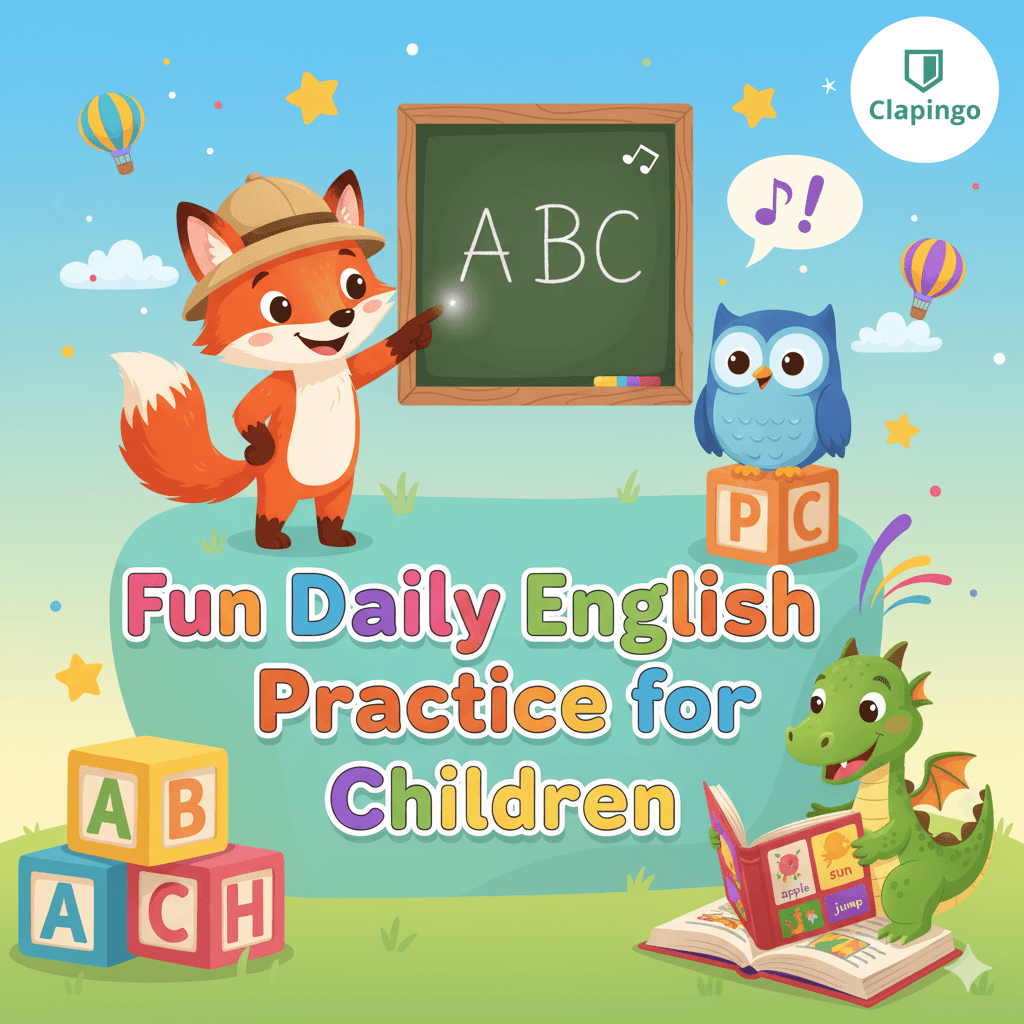English Learning for Kids: 7 Easy Tips for Parents
Discover 7 easy tips for kids’ English learning with 15 extra strategies for parents. Fun activities, parental guidance methods, and Clapingo support to boost your child’s English confidence.

How Parents Help Kids Speak Better English
Raising a child in today’s globalized world comes with the unique challenge of helping them develop strong English skills. English is no longer just another subject in school—it is a critical tool that opens doors to education, social interaction, and even future career opportunities. Yet many parents feel uncertain: “I’m not fluent in English myself. How can I guide my child?”
Here’s the good news: you don’t need to be a language expert to help your child thrive in English. With simple, consistent strategies, everyday practice, and a supportive learning environment, children can develop strong English skills naturally. This guide offers seven core tips for parents, enhanced with practical examples, stories, and 15 additional strategies to make English learning engaging, effective, and enjoyable. Along the way, you’ll also learn how platforms like Clapingo can support both parents and children in this journey.
Why Early English Learning Matters
Children’s brains are remarkably receptive to language, particularly during the early years. Research shows that children exposed to a second language before the age of seven often acquire pronunciation and grammar almost as easily as their first language.
Beyond academics, early English learning helps children develop cognitive skills, improve problem-solving abilities, and enhance creativity. For example, when a child learns to describe a scene in English, they are practicing observation, sequencing, and vocabulary simultaneously. Early exposure also builds confidence in communication, which is invaluable in school and social interactions.
Even parents who aren’t confident in English can support this early development. Simple daily habits—like asking, “What’s your favorite color today?” in English—can make a big difference. This approach is less about perfection and more about making English a normal, enjoyable part of life.

Daily English Learning Habits for Kids
Tip #1 – Make English Part of Everyday Conversations
Children learn language best when it’s part of their daily experiences. Instead of treating English as a separate subject, parents can integrate it naturally into everyday life.
For instance, during breakfast, you can ask your child, “Would you like toast or cereal?” Encourage them to answer in English. During chores, simple instructions like “Please fold the clothes” or “Can you help me sweep the floor?” provide contextual learning. Over time, these small interactions build vocabulary and fluency without creating stress.
A practical activity is the “English Word of the Day” game. Pick a new word daily and use it repeatedly throughout the day. For example, if the word is excited, you could say, “I’m excited to go to the park today. Are you excited too?” This repetition, combined with context, helps children internalize new vocabulary naturally.
Tip #2 – Read Together Every Day
Reading is one of the most powerful tools for kids’ English learning. It introduces children to new vocabulary, sentence structures, and storytelling techniques. But reading isn’t just about passing time—it’s an interactive, bonding activity.
Start with picture books, which provide visual cues for comprehension. As you read together, ask questions that encourage critical thinking: “Who do you think will help the main character next?” or “Why did the character feel sad?” Encourage your child to predict outcomes or create alternate endings. This practice develops imagination and language comprehension skills simultaneously.
Even children who are reluctant readers can be drawn in by using expressive voices, gestures, and acting out the story. Over time, reading sessions can evolve from 5-minute picture book sessions to longer chapter books, nurturing a lifelong love for English.
Tip #3 – Turn Screen Time into Learning Opportunities
Screen time doesn’t have to be wasted time. In fact, digital tools, when used thoughtfully, can significantly support English learning. For example, educational cartoons and nursery rhymes in English provide exposure to pronunciation, rhythm, and sentence structures. Platforms like Clapingo Kids offer interactive exercises that combine listening, speaking, and reading practice in an engaging, game-like environment.
Parents can watch content together with their children, pause to repeat phrases, or ask comprehension questions. For instance, after watching a short story, you could ask, “What did the cat do in the garden?” This encourages active listening and reinforces language acquisition.
Tip #4 – Make Speaking Fun Through Games
Many children struggle with speaking English because they fear making mistakes. Fun, interactive games create a low-pressure environment for practice.
Role-playing is particularly effective. Pretend to run a shop, with your child as the shopkeeper, and have conversations entirely in English. Games like “20 Questions” encourage curiosity and the use of complete sentences. Even tongue twisters, though challenging, improve pronunciation and make children aware of sounds and rhythm in English. For example, repeatedly practicing “Red lorry, yellow lorry” helps with articulation and fluency.
Games also provide opportunities for parent-child bonding while learning. Celebrating even small victories—like correctly pronouncing a tricky word—boosts confidence and motivates continued practice.
Tip #5 – Encourage Writing Early
Writing is often overlooked, yet it is an essential component of English proficiency. For young learners, writing can start as simply as drawing a picture and labeling objects in English, such as door, window, or tree. As children grow, encourage them to write short sentences describing their drawings or experiences: “I played football today.”
Creating a family English diary is another engaging method. Each family member can contribute one sentence per day, which encourages children to express thoughts clearly and consistently. Over time, this practice builds vocabulary, grammar awareness, and creative thinking.

English Learning For Kids with Clapingo
Tip #6 – Focus on Effort, Not Perfection
Language learning thrives in a positive environment. Children who are constantly corrected or criticized may develop a fear of speaking. Instead, parents should praise attempts and encourage communication, even if grammar is imperfect.
For instance, if a child says, “I goed to school,” rather than correcting immediately, you could respond with, “Great! You went to school today, what did you do there?” This reinforces the correct form in context while keeping confidence intact.
Celebrating milestones—like reading their first storybook or having a short conversation entirely in English—helps children associate English learning with achievement and enjoyment.
Tip #7 – Get Professional Support When Needed
While parental guidance is invaluable, professional support can accelerate learning. Platforms like Clapingo offer live one-on-one tutoring for children, providing structured lessons tailored to each child’s level. Tutors use interactive stories, games, and speaking exercises to maintain engagement.
Clapingo’s progress tracking allows parents to see areas where children excel and where extra practice is needed. This partnership ensures that children receive both structured learning and the freedom to explore English in a playful, stress-free environment.
Using Storytelling to Spark Imagination
Storytelling is more than just reading—it encourages creativity, expands vocabulary, and improves narrative skills. Encourage your child to invent their own stories. Start with prompts like, “Imagine you discover a secret door in your backyard. What happens next?” By narrating stories in English, children practice sentence formation, sequencing, and expressive language. Recording these stories also helps track progress and boosts self-confidence.

Daily English Learning Habits for Kids
Integrating English into Daily Activities
English learning can become seamless when incorporated into everyday activities. While cooking, name ingredients and describe steps in English: “Chop the carrots,” or “Pour the milk into the bowl.” While shopping, ask questions such as, “How much does this cost?” or “Which fruit is fresher?” These real-life applications reinforce practical language skills far more effectively than worksheets alone.
Encouraging Peer Interaction
Children often learn best from their peers. Organize playdates where English is encouraged, or facilitate small group activities like storytelling, role-playing, or word games. Children feel less self-conscious speaking English in a social context, which strengthens confidence and fluency.
Music and Songs as Learning Tools
Music naturally enhances language acquisition. Singing nursery rhymes and children’s songs exposes children to pronunciation patterns, rhymes, and vocabulary. Encourage your child to sing along, act out lyrics, or even create simple verses. These activities improve memory, pronunciation, and comprehension, while making learning joyful.
Using Visual Learning Aids
Visual aids such as flashcards, charts, and color-coded posters are excellent tools for reinforcing vocabulary. For example, a chart labeling household objects can turn everyday rooms into a learning environment. Reviewing these visuals regularly helps children recognize words quickly, associate meanings, and recall them during conversations.
Encouraging Journaling and Creative Writing
Writing provides children with a personal outlet to express ideas and emotions. A simple daily journal entry—even one sentence per day—builds writing confidence. As children grow, this can evolve into short stories, essays, or poems. Parents can participate by writing alongside children or offering prompts like, “Write about your favorite animal adventure today.”
Teaching Pronunciation Through Fun Techniques
Pronunciation is a crucial part of English fluency. Use playful techniques such as tongue twisters, phonics apps, or Clapingo exercises. Repetition, gentle correction, and playful mimicry can make learning sounds enjoyable. For example, practicing “She sells seashells by the seashore” can improve articulation while being fun.
Blending English with Hobbies
Children are more motivated when learning is connected to their interests. A child who loves drawing can label their artwork in English. A sports enthusiast can learn phrases like “Pass the ball” or “I scored a goal” in English. Linking language learning to hobbies ensures organic, sustained engagement.
Celebrating Small Wins
Recognizing and celebrating progress keeps children motivated. Mark milestones such as the first complete English conversation, learning 10 new words in a week, or reading a first storybook independently. Small rewards or verbal encouragement strengthen positive associations with English learning.
Encouraging Curiosity Through Questions
Curiosity drives language acquisition. Encourage children to ask questions in English about their surroundings or stories. For instance, after reading a book, prompt with “Why do you think the character acted that way?” Respond in English to reinforce comprehension and vocabulary.
Exploring Interactive Online Learning
Interactive platforms like Clapingo combine learning and play, offering children activities that focus on listening, speaking, reading, and vocabulary. These tools provide immediate feedback, adapt to your child’s pace, and help parents track improvement. Children often engage longer with interactive sessions than with passive reading alone.
Creating a Home Library
A home library dedicated to English books encourages independent exploration. Include a mix of picture books, early readers, and storybooks. Let children choose books that interest them. Reading in a cozy corner or as a family ritual makes the experience enjoyable and natural.
Enhancing Listening Skills
Listening is foundational to language learning. Audiobooks, stories, and songs can develop comprehension and pronunciation. Parents can pause the story to ask questions, discuss character motivations, or repeat challenging sentences. Listening exercises combined with speaking ensure well-rounded learning.
Promoting Independent Learning
Encourage children to take initiative in learning. Let them complete short exercises, record themselves reading, or narrate stories. Independent learning fosters responsibility, builds confidence, and strengthens problem-solving skills, while giving parents a chance to guide without pressure.
Real-Life Application of English
Practical use of language helps solidify learning. Encourage children to order food in English, greet neighbors, or explain simple concepts at home. Role-playing emergency scenarios, like calling for help, can be both fun and educational, teaching children confidence in everyday communication.
Tracking Progress
Regular assessment ensures that your child is improving steadily. Track vocabulary learned, stories read, or sentences written. Clapingo’s progress reports can guide parents in identifying areas of strength and areas needing attention. Celebrate progress to maintain motivation and enthusiasm for English.
Making Learning Collaborative
Family involvement strengthens learning outcomes. Storytelling nights, English word games at the dinner table, or sibling collaborations make language practice interactive and enjoyable. Collaborative learning nurtures communication, empathy, and confidence in children.

How Parents Support Kids Speak Better English
Conclusion
Helping your child learn English is a journey rather than a race. By combining consistent practice, interactive storytelling, games, music, and professional support through platforms like Clapingo, parents can create an environment where children thrive in English naturally and joyfully.
With these 7 main tips and 15 expanded strategies, children develop confidence, communication skills, and a lifelong love for English, setting them up for success in school and beyond.
Read Also: How to Improve English Speaking at Home: 7 Fluency Tips for Beginners